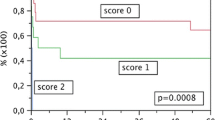Abstract.
Abstract.
Background/Purpose:
We investigated the causes and examined patient outcomes following the postrevascularization syndrome (PRS) during orthotopic liver transplantation (OLTx).
Methods:
PRS was defined as a fall in the mean arterial pressure at 5 min after revascularization to less than 70% of the baseline and lasting for 5 min. Data from 100 adult patients who underwent OLTx between January 1998 and September 2000 were analyzed. Analyzed data included donor and recipient demographic data, recipient operative and postoperative courses, and recipient outcome.
Results:
Twenty-nine patients (29%) exhibited PRS during OLTx (PRS group). There was a higher incidence of older donors (>50 years) in the PRS group (48% vs 23%; P < 0.05). Postrevascularization hyperkalemia and metabolic acidosis were observed in both the PRS and non-PRS groups. Transaminase and lactate levels after revascularization were significantly higher in the PRS group (P < 0.05). Alkaline phosphatase and gamma-glutamyl transpeptidase levels on day 7 tended to be higher in the PRS group; although the difference was not significant (p ≧ 0.05). Serum creatinine was significantly elevated on day 7 in the PRS group (P < 0.01).
Conclusions:
Our results indicate that PRS following OLTx tended to be more common in liver allografts from older donors and was associated with posttransplantation liver and renal dysfunction.
Article PDF
Similar content being viewed by others
Avoid common mistakes on your manuscript.
Author information
Authors and Affiliations
Additional information
Received: May 11, 2001 / Accepted: September 26, 2001
About this article
Cite this article
Nanashima, A., Pillay, P., Crawford, M. et al. Analysis of postrevascularization syndrome after orthotopic liver transplantation: the experience of an Australian liver transplantation center. J Hep Bil Pancr Surg 8, 557–563 (2001). https://doi.org/10.1007/s005340100025
Issue Date:
DOI: https://doi.org/10.1007/s005340100025




